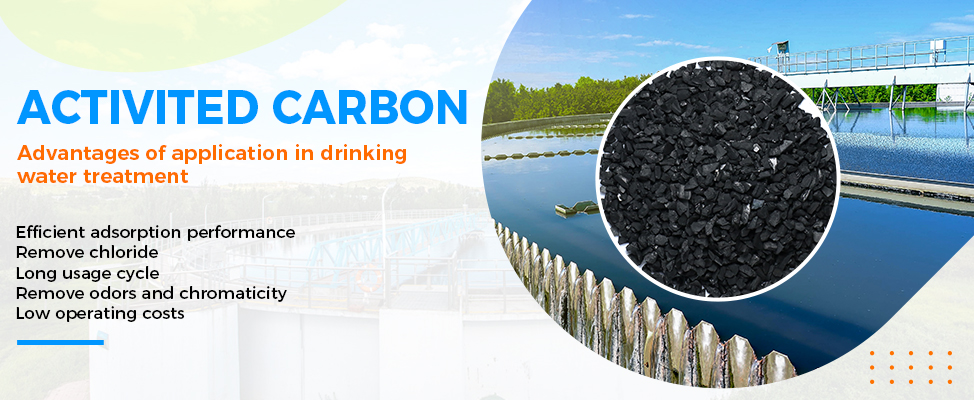
Activated carbon is a material with a large surface area and numerous pores, known for its powerful adsorption capabilities. It is widely used in water treatment, air purification, chemical analysis, and other fields. In drinking water treatment, activated carbon plays a key role in adsorbing harmful substances in water, such as organic pollutants, residual chlorine, heavy metal ions, and unpleasant odors. Due to its unique chemical properties, activated carbon is an indispensable material in the global water treatment industry.
Effective Removal of Organic Pollutants
-Application: Organic substances in drinking water, such as pesticides, solvents, and industrial wastewater residues, are major sources of water contamination. Activated carbon can effectively adsorb organic pollutants from water, preventing them from entering the human body.
-Advantage: Activated carbon’s large surface area allows it to adsorb a significant amount of organic materials, ensuring that water meets safety standards.
Removal of Residual Chlorine and Chlorides
-Application: Residual chlorine is a common disinfectant by-product in municipal water treatment. Although it kills bacteria, prolonged exposure to chlorine can be harmful to human health. Activated carbon can effectively adsorb residual chlorine from water.
-Advantage: Activated carbon’s strong adsorption capacity for chlorine ions effectively reduces chlorine taste and odor, improving water quality and making it more palatable.
Removal of Heavy Metal Ions
-Application: Heavy metal ions such as lead, mercury, and arsenic in drinking water can pose serious health risks. Activated carbon has some advantages in adsorbing heavy metal ions, helping to remove these harmful substances from water.
-Advantage: Activated carbon can adsorb heavy metal ions through physical and chemical interactions, providing users with safer, healthier drinking water.
Improving Taste and Odor of Water
-Application: Unpleasant tastes and odors in drinking water often come from organic substances, algae, and certain chemicals. Activated carbon can remove these odors, improving the taste of water.
-Advantage: Due to its strong adsorption capabilities, activated carbon effectively eliminates odor-causing substances, ensuring that the water tastes fresher and providing a better drinking experience.
Reducing Microbial Contamination in Water
-Application: While activated carbon does not have direct bactericidal properties, it can adsorb microorganisms and pathogens in water, helping to reduce bacterial contamination.
-Advantage: Activated carbon’s ability to adsorb bacteria and viruses offers additional support in purifying water, helping to reduce the risk of disease transmission.
Activated carbon works primarily based on its large surface area and porous structure. The pore network in activated carbon effectively captures molecules in the water, particularly larger organic molecules and pollutants. Through physical adsorption and chemical reactions, activated carbon removes these contaminants from water, thus improving water quality.
Additionally, activated carbon can adsorb harmful substances like chlorine, fluoride, and nitrates from water, forming stable compounds that further purify the water.
Choosing the Right Type of Activated Carbon
-Application: There are various types of activated carbon on the market, including Granular Activated Carbon (GAC), Powdered Activated Carbon (PAC), and others. Selecting the appropriate type of activated carbon can improve the effectiveness of water treatment.
-Recommendation: For household or small-scale water treatment, Granular Activated Carbon (GAC) is commonly used. For large-scale industrial water treatment, Powdered Activated Carbon (PAC) and Block Activated Carbon (BAC) may be more suitable.
Methods of Using Activated Carbon
-Application: Activated carbon can be used alone or in combination with other water treatment technologies, such as reverse osmosis or ultrafiltration. When using activated carbon, it’s essential to design the correct dosage and frequency based on water quality and treatment needs.
-Recommendation: Regularly replacing activated carbon and performing backwashing can extend its service life and ensure sustained adsorption effectiveness.
Regeneration and Replacement of Activated Carbon
-Application: Over time, the adsorption capacity of activated carbon decreases, which reduces its water treatment effectiveness.
-Recommendation: For large-scale water treatment systems, activated carbon regeneration technology can effectively reduce operational costs by allowing the reuse of the carbon.
Activated carbon offers significant advantages in drinking water treatment. It effectively removes harmful substances from water and improves the taste and odor of drinking water. By selecting the right type of activated carbon, using it correctly, and performing regular maintenance such as backwashing and regeneration, long-term water quality and safety can be ensured.
In the future of water treatment technology, the application of activated carbon will become even more widespread. With ongoing technological advancements, the efficiency and cost-effectiveness of activated carbon will continue to improve, contributing to providing cleaner and safer drinking water.

Please contact us for free quotation by form below. We promise the quickest response within 24 hours: